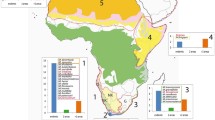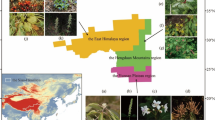Summary
1. The Madro-Tertiary Geoflora comprises semiarid live oak-conifer woodland, chaparral, arid subtropic scrub, plains (desert) grassland, and subdesert to desert vegetation.
2. The taxonomic and adaptive relations of its plants suggest that it was derived chiefly from subtropical to warm temperate groups that evolved in response to the expansion of a new adaptive zone—dry climate.
3. The geoflora seems to have had an origin in southwestern North America because (a) types that appear to be ancestral to Madro-Tertiary lineages are represented in the Cretaceous and Paleocene floras of that region, (b) they are not known from the temperate Arcto-Tertiary Geoflora to northward, and (c) they are not recorded in the humid phases of the Neotropical-Tertiary Geoflora.
4. Geologic and paleoclimatic data suggest that southwestern North America was generally a lowland region, characterized by tropic savanna climate during the Cretaceous and Early Tertiary.
5. During this interval, ancestral Madro-Tertiary phylads probably were evolving chiefly in sites away from the moist lowland floodplains, in drier areas provided by local edaphic and climatic conditions.
6. With a strong linear component to selection imposed by a gradual trend toward increased aridity, these scattered, isolated phylads of subtropic to warm temperate affinities may have been undergoing megaevolution during the Cretaceous and Paleocene, giving rise to numerous, highly specialized taxonomic and adaptive types.
7. When first recorded in moderate numbers in the Eocene and early Oligocene, they are closely similar to modern species.
8. As dry climates continued to expand in area and to increase in severity, the Madro-Tertiary Geoflora migrated widely over southwestern North America. The stage during which it attained dominance in each province was governed chiefly by geographic position and time.
9. In response to the evolution of new dry climates in the later Cenozoic, each of the generalized Madro-Tertiary communities was differentiated into a number of modern associations that are adapted now to more localized dry environments.
Similar content being viewed by others
Bibliography
Anderson, C. A. 1950. Geology of islands and neighboring land areas.In: 1940 E. W. Scripps Cruise to the Gulf of California. Geol. Soc. Amer., Mem.43: 1–53.
Axelrod, D. I., 1934. A Pliocene flora from the Eden beds. Amer. Mus. Nov.729: 1–4.
-----, 1937. A Pliocene flora from the Mount Eden beds, southern California. Carnegie Inst. Wash., Pub. 476: 125–183.
—————, 1938. The stratigraphic significance of a southern element in later Tertiary floras of western America. Jour. Wash. Acad. Sci.28: 314–322.
-----, 1939. A Miocene flora from the western border of the Mohave Desert. Carnegie Inst. Wash., Pub. 516: 1–129.
—————, 1940a. The Pliocene Esmeralda flora of west-central Nevada. Jour. Wash. Acad. Sci.30: 163–174.
—————, 1940b. Late Tertiary floras of the Great Basin and border areas. Bull. Torrey Bot. Club67: 477–487.
—————, 1940c. The Mint Canyon flora of southern California: a preliminary statement. Amer. Jour. Sci.238: 577–585.
-----, 1944a. The Black Hawk Ranch flora (California). Carnegie Inst. Wash., Pub. 553: 91–101.
-----, 1944b. The Mulholland flora (California). Carnegie Inst. Wash., Pub. 553: 102–146.
-----, 1944c. The Oakdale flora (California). Carnegie Inst. Wash., Pub. 553: 147–165.
-----, 1944d. The Sonoma flora (California). Carnegie Inst. Wash., Pub. 553: 166–206.
-----, 1944e. The Pliocene sequence in central California. Carnegie Inst. Wash., Pub. 553: 207–224.
-----, 1944f. The Alvord Creek flora (Oregon). Carnegie Inst. Wash., Pub. 553: 225–262.
-----, 1944g. The Alturas flora (California). Carnegie Inst. Wash., Pub. 553: 263–284.
—————, 1948. Climate and evolution in western North America during Middle Pliocene time. Evolution2: 127–144.
-----, 1950a. Classification of the Madro-Tertiary Flora. Carnegie Inst. Wash., Pub. 590: 1–22.
-----, 1950b. A Sonoma florule from Napa, California, Carnegie Inst. Wash., Pub. 590: 23–71.
-----, 1950c. Further studies of the Mount Eden flora, southern California. Carnegie Inst. Wash., Pub. 590: 73–117.
-----, 1950d. The Anaverde flora of southern California. Carnegie Inst. Wash., Pub. 590: 119–158.
-----, 1950e. The Piru Gorge fiora of southern California. Carnegie Inst. Wash., Pub. 590: 161–214.
-----, 1950f. Evolution of desert vegetation in western North America. Carnegie Inst. Wash., Pub. 590: 215–360.
—————, 1952a. A theory of angiosperm evolution. Evolution6: 29–60.
—————, 1952b. Variables affecting the probabilities of dispersal in geologic time. Bull. Amer. Mus Nat. Hist.99: 177–188.
—————, 1956. Mio-Pliocene floras from west-central Nevada. Univ. Calif., Publ. Geol. Sci.33: 1–322.
—————, 1957. Late Tertiary floras and the Sierra Nevadan uplift. Bull. Geol. Soc. Amer.68: 19–46.
Bailey, I. W., andE. W. Sinnott, 1915. A botanical index of Cretaceous and Tertiary climates. Science, n. s.41: 832–833.
—————, 1916. Investigations on the phylogeny of the angiosperms. 6: The climatic distribution of certain types of angiosperm leaves. Amer. Jour. Bot.3: 23–39.
Ball, O. M., 1931. A contribution to the paleobotany of the Eocene of Texas. Bull. Agr. & Mech. College Texas. IV.2: 1–172.
Berry, E. W., 1916. The Lower Eocene floras of southeastern North America. U. S. Geol. Survey, Prof. Paper 91: 21–353.
—————, 1919. An Eocene flora from Trans-Pecos Texas. U. S. Geol. Surveys, Prof. Paper 125: 1–9.
—————, 1930. Revision of the Lower Eocene Wilcox flora of the Southeastern United States, with descriptions of new species, chiefly from Tennessee and Kentucky. U. S. Geol. Survey, Prof. Paper 156: 1–196.
Bews, J. W. 1927. Studies in the ecological evolution of angiosperms. New Phytol.26: 1–21, 65–84, 129–148, 209–248, 273–294.
Bradley, W. H., 1929. The varves and climate of the Green River epoch. U. S. Geol. Survey, Prof. Paper 158: 87–110.
Brandegee, T. S., 1889. A collection of plants from Baja California. Proc. Cal. Acad. Sci., II.,2: 117–216.
Brown, R. W., 1934. Recognizable species of the Green River flora. U. S. Geol. Survey, Prof. Paper 185: 45–77.
Cain, S. A., 1944. Foundation of plant geography. 556 pp. Harper & Bros., N. Y.
Chaney, R. W., 1938. Paleoecological interpretations of Cenozoic plants in western North America. Bot. Rev.4: 371–396.
-----, 1944a. Introduction (to Pliocene floras of California and Oregon). Carnegie Inst. Wash., Pub. 553: 1–19.
-----, 1944b. Summary and Conclusions (to Pliocene floras of California and Oregon). Carnegie Inst. Wash., Pub. 553: 353–373.
—————, 1944c. A fossil cactus from the Eocene of Utah. Amer. Jour. Bot.31: 507–528.
—————, 1947. Tertiary centers and migration routes. Ecol. Monog.17: 139–148.
-----, 1958. Miocene forests of the Columbia Plateau. Carnegie Inst. Wash., Pub. 617.
-----, andH. L. Mason, 1934. A Pleistocene flora from the asphalt deposits at Carpenteria, California. Carnegie Inst. Wash., Pub. 415: 47–79.
-----, andE. I. Sanborn, 1933. The Goshen flora of west-central Oregon. Carnegie Inst. Wash., Pub. 439: 1–103.
Clements, F. E., 1920. Plant indicators. Carnegie Inst. Wash., Pub. 290: 1–388.
-----, 1936. The origin of the desert climax and climate,In: Essays in geobotany in honor of William Albert Setchell. [T. H. Goodspeed, ed.] Univ. Calif. Press: 87–140.
Condit, C., 1944a. The Remington Hill flora (California). Carnegie Inst. Wash., Pub. 553: 21–55.
-----, 1944b. The Table Mountain flora (California). Carnegie Inst. Wash., Pub. 553: 57–90.
Corey, W. H., 1955. Tertiary basins of southern California.In: Historical Geology: 73–83. Geology of Southern California, State of California, Dept. of Natural Resources, Div. of Mines, Bull. 170.
Dorf, E., 1930. Pliocene floras of California. Carnegie Inst. Wash., Pub. 412: 1–112.
-----, 1942. Upper Cretaceous floras of the Rocky Mountain region. Carnegie Inst. Wash., Pub. 508: 1–168.
Elias, M. K., 1942. Tertiary prairie grasses and other herbs from the High Plains. Geol. Soc. Amer., Spec. Pap. 41: 1–176.
Gray, Asa, 1878. Forest geography and archaeology. Amer. Jour. Sci. & Arts. III.16: 85–95.
—————, 1884. Characteristics of the North American flora. Amer. Jour. Sci. & Arts. III.28: 323–340.
Gregory, H. E., 1917. Geology of the Navajo country. U. S. Geol. Survey, Prof. Paper 93: 1–161.
Harshberger, J. W., 1912. Phytogeographic survey of North America.In: Engler and Drude, Vegetation der Erde. Vol. 13.
Hemsley, W. B., 1888. Biologia centrali-americana; or contributions to the knowledge of the fauna and flora of Mexico and Central America ... Botany4: 306–314.
Imlay, R. W., 1944, Cretaceous formations of central America and Mexico. Bull. Amer. Assoc. Petrol. Geol.28: 1077–1195.
Johnston, I. M., 1940. The floristic significance of shrubs common to North and South American deserts. Jour. Arn. Arb.21: 356–363.
Knowlton, F. H., 1917. Fossil floras of the Vermejo and Raton formations of Colorado and New Mexico. U. S. Geol. Survey. Prof. Paper 101: 223–450.
—————, 1922. The Laramie flora of the Denver basin. U. S. Geol. Survey, Prof. Paper 130: 1–168.
—————, 1923. Fossil plants from the Tertiary lake beds of south-central Colorado. U. S. Geol. Survey, Prof. Paper 131: 183–197.
—————, 1924. Flora of the Animas formation. U. S. Geol. Survey, Prof. Paper 134: 71–117.
—————, 1930. The flora of the Denver and associated formations of Colorado. U. S. Geol. Survey, Prof. Paper 155: 1–142.
LeConte, J., 1887. The flora of the coast islands of California in relation to recent changes of physical geography. Bull. Calif. Acad. Sci.2: 515–520.
Lesquereux, L., 1887. List of recently identified fossil plants belonging to the U. S. National Museum with descriptions of several new species. Proc. U. S. Nat. Mus.10: 21–46.
Mason, H. L., 1947. Evolution of certain floristic associations in western North America. Ecol. Monog.17: 201–210.
MacGinitie, H. D., 1937. The flora of the Weaverville beds of Trinity County, California. Carnegie Inst. Wash., Pub. 465: 83–151.
-----, 1941. A Middle Eocene flora from the central Sierra Nevada. Carnegie Inst. Wash., Pub. 1–178.
-----, 1953. Fossil plants of the Florissant beds, Colorado. Carnegie Inst. Wash., Pub. 599: 1–188.
Munz, P. A., 1935. A manual of southern California botany. 642 pp. Claremont, Calif.
Muller, C. H., 1939. Relations of the vegetation and climatic types in Nuevo Leon, Mexico. Amer. Mid. Nat.21: 687–729.
Nelson, E. W., 1921. Lower California and its natural resources. Mem. Nat. Acad. Sci.16.
Potbury, S. S., 1935. The LaPorte flora of Plumas County, California. Carnegie Inst. Wash., Pub. 465: 29–81.
Pringle, C. G., 1888. The vegetation of northern Mexico. Garden & Forest1: 117, 141–142.
—————, 1890. Notes on the ligneous vegetation of the Sierra Madre of Nuevo Leon. Garden & Forest3: 337–338, 362–363.
Shreve, F., 1937. The vegetation of the Cape Region of Baja California. Madroño4: 105–113.
—————, 1951. Vegetation of the Sonoran Desert. Carnegie Inst. Wash., Pub. 591, vol. 1: 1–192.
Simpson, G. G., 1953. The major features of evolution. 434 pp. Columbia.
Stebbins, J. L., Jr., 1947. Evidence on rates of evolution from the distribution of existing and fossil plant species. Ecol. Monog.17: 149–158.
-----, 1950. Variation and evolution in plants. 643 pp. Columbia.
—————, 1952. Aridity as a stimulus to plant evolution. Amer. Nat.86: 33–44.
Stewart, B. K., 1940. Plant ecology and paleo-ecology of the Creede Valley, Colorado. Univ. Col., Ph.D. thesis.
Wodehouse, R. P., 1932. Tertiary pollen. I. Pollen of the living representatives of the Green River flora. Bull. Torrey Bot. Club59: 313–340.
—————, 1933. Tertiary pollen. II. The oil shales of the Green River formation. Bull. Torrey Bot. Club60: 479–521.
Author information
Authors and Affiliations
Additional information
This review is a summary of research which has been generously supported by the Carnegie Institution of Washington (1934–46), the National Research Council (1939–41), the Geological Society of America (1948–50), the John Simon Guggenheim Memorial Foundation (1952–3), the Committee on Research, University of California, Los Angeles (1946–48, 1950–52), and the National Science Foundation (1954–57).
Rights and permissions
About this article
Cite this article
Axelrod, D.I. Evolution of the madro-tertiary geoflora. Bot. Rev 24, 433–509 (1958). https://doi.org/10.1007/BF02872570
Issue Date:
DOI: https://doi.org/10.1007/BF02872570




